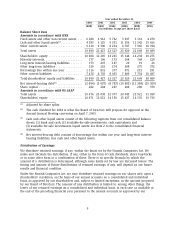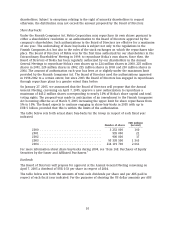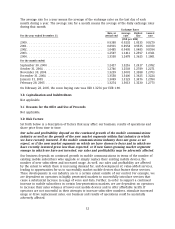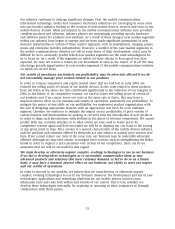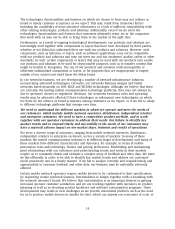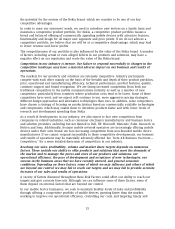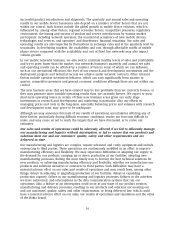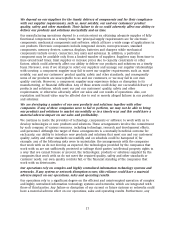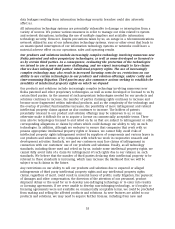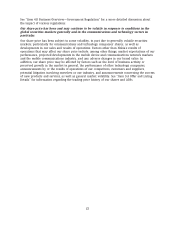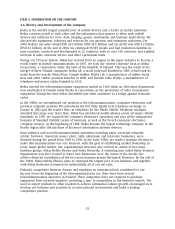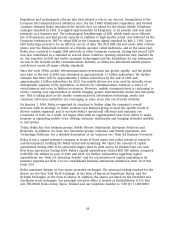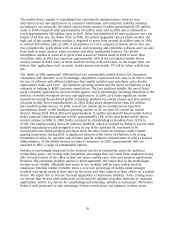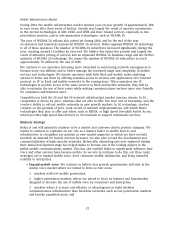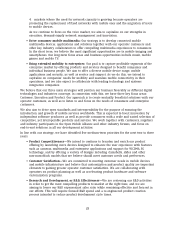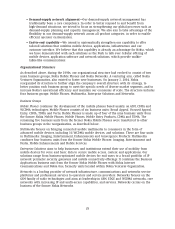Nokia 2004 Annual Report Download - page 20
Download and view the complete annual report
Please find page 20 of the 2004 Nokia annual report below. You can navigate through the pages in the report by either clicking on the pages listed below, or by using the keyword search tool below to find specific information within the annual report.sometimes unidentified owners of intellectual property. The cumulative costs of obtaining any
necessary licenses are difficult to predict and may over time have a negative effect on our
operating results.
In addition, other companies may commence actions seeking to establish the invalidity of our
intellectual property, for example, patent rights. In the event that one or more of our patents are
challenged, a court may invalidate the patent or determine that the patent is not enforceable,
which could harm our competitive position. If any of our key patents are invalidated, or if the
scope of the claims in any of these patents is limited by a court decision, we could be prevented
from licensing the invalidated or limited portion of our intellectual property rights. Even if such a
patent challenge is not successful, it could be expensive and time consuming, divert management
attention from our business and harm our reputation. Any diminution of the protection that our
own intellectual property rights enjoy could cause us to lose some of the benefits of our
investments in R&D, which may have a negative effect on our results of operations. See ‘‘Item 4.B
Business Overview—Patents and Licenses’’ for a more detailed discussion of our intellectual
property activities.
If we are unable to recruit, retain and develop appropriately skilled employees, we may not
be able to implement our strategies and, consequently, our results of operations may suffer.
We must continue to recruit, retain and through constant competence training develop
appropriately skilled employees with a comprehensive understanding of our businesses and
technologies. As competition for skilled personnel remains keen, we seek to create a corporate
culture that encourages creativity and continuous learning. We are also continuously developing
our compensation and benefit policies and taking other measures to attract and motivate skilled
personnel. Nevertheless, we have encountered in the past, and may encounter in the future,
shortages of appropriately skilled personnel, which may hamper our ability to implement our
strategies and harm our results of operations.
The global networks business relies on a limited number of customers and large multi-year
contracts. Unfavorable developments under such a contract or in relation to a major
customer may affect our sales, our results of operations and cash flow adversely.
Large multi-year contracts, which are typical in the networks industry, include a risk that the
timing of sales and results of operations associated with these contracts will be different than
expected. Moreover, they usually require the dedication of substantial amounts of working capital
and other resources, which impacts our cash flow negatively. Any non-performance by us under
these contracts may have significant adverse consequences for us because network operators have
demanded and may continue to demand stringent contract undertakings such as penalties for
contract violations.
Our sales derived from, and assets located in, emerging market countries may be adversely
affected by economic, regulatory and political developments in those countries. As sales from
these countries represent an increasing portion of our total sales, economic or political
turmoil in these countries could adversely affect our sales and results of operations. Our
investments in emerging market countries may also be subject to other risks and
uncertainties.
We generate sales from and have invested in various emerging market countries. As sales from
these countries represent an increasing portion of our total sales, economic or political turmoil in
these countries could adversely affect our sales and results of operations. Our investments in
emerging market countries may also be subject to risks and uncertainties, including unfavorable
taxation treatment, exchange controls, challenges in protecting our intellectual property rights,
19


